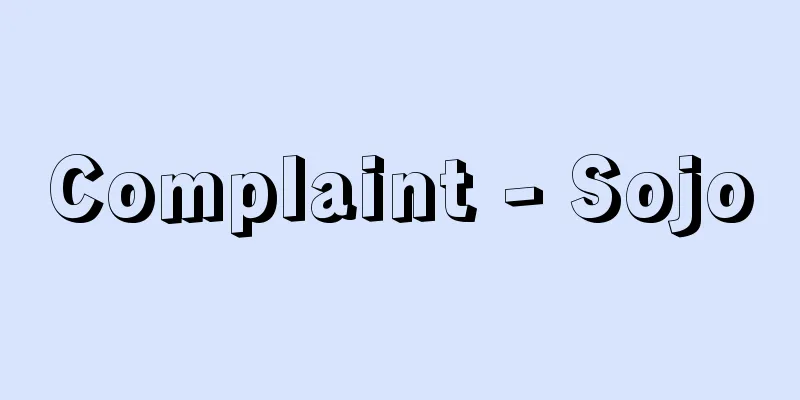Complaint - Sojo

|
〘noun〙① A document that records a complaint. (a) A document submitted to the court when a lawsuit is filed. *Ryo Gikai (718) official text: "The official office will submit the complaint. It will not be immediately decided, and a decision will be made later." [Song Shu - Wen Five Kings' Record] (b) A document submitted to the shogunate's kubari magistrate's office along with supporting documents as part of the procedure for filing a lawsuit in the Middle Ages . The format was not stipulated by law, but it was roughly similar (Sataminensho (early 14th century)). It is also called a petition, a resolution, or a guideline. The first complaint is called a honkaijo or shomonjo, the second complaint is called a nimonjo, and the third is called a sanmonjo, and complaints below that are called jomonjo or jomonjo. ⇔ Chinjo or somonjo. ※Goseibai Shikimoku (1232), Article 35: "In the above, a petition shall be filed and a summons shall be sent, and if there is still no vote , the plaintiff shall be tried and sentenced . " (Ha) A written document submitted to a lord or ruler when making a request. Petition. Appeal. ※Inryoken Nikki - February 15, 1465 (Kansho 6): "At this time , the two parties shall be pardoned . The two parties shall file a petition ." ② In civil lawsuits, a document that describes the purpose of the lawsuit and is submitted to the court. [Civil Procedure Code (1890) (Meiji 23)] [Glossary] (1) As a document style, ① is derived from " Kage" . The opening is often "Someone respectfully submits" or "Someone respectfully submits" and the closing is often "Submit as requested" or "Plead as requested." It is common not to write the addressee's name, but as time went on, more and more letters included the sender's name and the addressee's name. After the Nanboku-cho period, letters began to be written with "Guide" at the beginning and "Guide to the addressee" at the end. (2) In the litigation system of the Kamakura Shogunate, when a plaintiff filed a complaint, the defendant was asked to submit a statement of his or her rebuttal. This complaint and statement was submitted three times, and the court decided whether the case was right or wrong, and then issued a writ of judgment. A petition for a retrial against a ruling was called an ossojo . (3) In the early modern period, it took the form of a petition, and many of them began with "We hereby submit this petition to you" and ended with "We hereby submit this petition, the end," with the sender's name written underneath and the recipient's name clearly stated. Therefore, petitions and complaints are distinguished based on their contents. Source: The Selected Edition of the Japanese Language Dictionary About the Selected Edition of the Japanese Language Dictionary Information |
|
〘名〙① 訴えごとを記した文書。(イ) 訴訟を起こすとき、裁判所に提出する文書。※令義解(718)公式「官司准二其訴状一。即下二推不レ給所由一。然後断決」 〔宋書‐文五王伝〕(ロ) 中世、訴人が訴訟を起こす手続きとして、証拠文書などをそえて幕府の賦(くばり)奉行方に提出した文書。その書式は法で定められてはいなかったが、おおよそ類似の様式によっている(沙汰未練書(14C初))。申状・解状(げじょう)・目安ともいう。また最初の訴状を本解状・初問状、二回目の訴状を二問状、三回目のを三問状といい、二問状以下を重訴状・重申状という。⇔陳状(ちんじょう)・訴陳状。※御成敗式目(1232)三五条「右就二訴状一、遣二召文一事、及二三ケ度一 猶不二参決一者、訴人有レ理者、直可レ被二裁許一」(ハ) 願いごとをするとき、領主、支配者などに提出する書付け。願書。嘆願書。※蔭凉軒日録‐寛正六年(1465)二月一五日「以二此時一彼二人赦免之事。自二門中一以二訴状一申レ之」② 民事訴訟で、訴えの趣旨を記載して裁判所に提出する書面。〔民事訴訟法(明治二三年)(1890)〕[語誌](1)文書様式としての①は「解(げ)」の系統を引くものである。書出しは「何某謹言上」「何某謹訴申」などで、書止めは「言上如件」「訴申如件」などが多い。宛名は書かないのが普通であるが、時代が下ると共に差出人名・宛名を記したものが多くなる。南北朝時代以後は、書出しに「目安」と記し、書止めに「目安言上如件」と記すものが見られるようになる。 (2)鎌倉幕府の訴訟制度では訴人が訴状を提出すると、被告人にそれに対する反論を書いた陳状の提出を求めた。この訴状・陳状の提出を三回ずつ行ない、理非を判断し、裁許状を発給した。裁許に対する再審請求の訴えを越訴(おっそ)状という。 (3)近世になると願書の形式をとり、書出しは「乍恐書付を以御訴訟申上候」、書止めは「乍恐可奉申上候、以上」などと記したものが多く、日下に差出人名を記し、宛名を明記している。したがって内容によって願書と訴状の区別をすることになる。 出典 精選版 日本国語大辞典精選版 日本国語大辞典について 情報 |
<<: Litigation records - Sosho Kiroku
Recommend
Dioscorea bulbifera (English spelling)
…[Shinichi Suzuki]. … *Some of the terminology th...
Lake Akimoto - Akimotoko
Also known as Lake Agatsuma. A lake in the northea...
first use
...First strike capability and second strike capa...
Microlithography
…It plays an important role in the manufacture of...
Death
It is a concept that is contrasted with life or v...
Chonan [town] - Chonan
A town in Chosei County in central Chiba Prefectur...
Gerbert (of Aurillac)
940-1003 Gerbertus (Latin name: Gerbertus) was a F...
November group
… In this way, expressionist art around the time ...
Hepatopancreas - Kansuizo
→ Midgut gland Source: Asakura Publishing Nutritio...
Paralexia
…Intralingual disorders inevitably lead to simila...
Sacrifice - Nie
It can refer to offerings to gods, or food sent f...
Obruchev, SV - Obruchev
...There are gold, tin, and other deposits in the...
River Barrow
The River Originates in the Slieve Bloom Mountains...
Kuroko - Haha shit
〘Noun〙 (Even in the era of "hawakuso") M...
Mattschie's tree-kangaroo
The kangaroo is a member of the mammalian order M...









